








| Green Frogs (Pelophylax sp. (Fitzinger, 1843)) |









|
|
Scientific name: Pelophylax sp. (Fitzinger, 1843) Common name: Green Frogs Other names: The Rana genus previously used for the European green frogs is now restricted to the brown frogs. French name: Grenouilles vertes Order: Anura Family: Ranidae Size: Marsh Frog (Pelophylax ridibunda) : 8 to 15 cm, like for all the other species listed on this page males are smaller than females; Pool Frog (Pelophylax lessonae) : 4.5 to 8 cm; Perez's Frog (Pelophylax perezi) : 3 to 10 cm; Edible Frog (Pelophylax kl. esculenta) : 5 to 11 cm; Graf's Hybrid Frog (Pelophylax kl. grafi) : 7 to 8 cm for males and 7 to 11 cm for females. Habitat: Marsh Frogs prefer aquatic habitats with a water rich of oxygen, rivers, gravel beds, large size lakes and ponds with sandy or gravelly bottoms. Pool Frogs are found in smaller aquatic habitats, sometimes isolated or temporary with a water poor in oxygen and with a rather muddy bottom. Edible Frogs live in very various habitats and in particular in habitats of intermediate type. Perez's Frogs and Graf's Hybrid Frogs may be found in all the habitats previously mentioned. Food: Larvae, worms, insects and other arthropods. Reproduction: Mating occurs between February and April. Females can lay up to 4000 eggs into water. Tadpoles will grow during 2 or 3 months before metamorphosis. There is a slight time difference, the Pool Frogs are the first to come out of hibernation. They are followed by the Edible Frogs and then by the Marsh Frogs. Geographic area: Marsh Frog (Pelophylax ridibunda) : Eastern and central temperate Europe (with a recent western extension because of many introductions) and western temperate Asia east to Kazakhstan, Middle-East, it has been introduced to Great Britain, to northern Italia and in many other regions.; Pool Frog (Pelophylax lessonae) : Europe and western Asia east to the Ural, missing in the Iberian Peninsula, in central and southern Italia and in Scandinavia except some isolated populations; Perez's Frog (Pelophylax perezi) : Iberian Peninsula and south of France north to Vendée and to the region of Lyon; Edible Frog (Pelophylax kl. esculenta) : Europe, from the northern half of France to western Russia, from northern Italy and Bulgaria north to Denmark and Estonia; Graf's Hybrid Frog (Pelophylax kl. grafi) : North of Spain and south of France. |
The Pelophylax genus includes the European green frogs, that's to say, in France, the 3 original species, the Marsh Frog (Pelophylax ridibunda), the Pool Frog (Pelophylax lessonae) and the Perez's Frog (Pelophylax perezi) to which you need to add hybrids, the Edible Frog (Pelophylax kl. esculenta) coming from the hybridization between Pelophylax ridibunda and Pelophylax lessonae and the Graf's Hybrid Frog (Pelophylax kl. grafi) coming from the hybridization between Pelophylax ridibunda and Pelophylax perezi. Telling species apart in the field is very difficult. These Frogs are characterized by the lack of well visible temporal patches, a green colour which may vary to dark greenish brown and external resonators on males. There are two visible lines of glands on the back. During the breeding period males exhibit metatarsal tubercles. The Marsh Frog is characterized by its large size. The snout is long and rounded, the legs are powerful. The back is generally very colourful and quite dark. The underside is cream with black-grey spots. The Iris is dark, almost black. Males have very dark resonators and flattened metatarsal tubercles. The Pool Frog is significantly smaller. The snout is short and pointed, legs are short and not very powerful. The back is rather light green or yellowish. The underside is white and spotless. The iris is uniform golden yellow. Males have white resonators and globular metatarsal tubercles. The Perez's Frog is also a small size. The legs are short and not very powerful. The back is greenish to brown. The underside is white with brown or grey spots. Males have dark resonators and triangular metatarsal tubercles. Hybrids have intermediate characteristics compared to parental species. Some identification keys are also using the colour of the inner side of the thighs, the shape of the vomerine teeth and the shape of the webbed hind legs. Their calls is also an important criterion to try to tell species and hybrids apart. It is even recommended to use it in addition to the other morphological criteria. The Marsh Frog has a jerky call with short series of 4 to 5 sounds (about 1 second per series) followed by a short break. This looks like a laughing call is this is the origin of the French common name: Grenouille rieuse (Laughing Frog). On the contrary the Pool Frog has a monotonous call made of a series of very fast sounds emitted continuously during at least 15 seconds and often much more. The Edible Frog's call is very similar to the Pool Frog's call but the intensity varies over time by progressively increasing and then suddenly falling after 2 or 3 seconds. The Perez's Frog's call is also very similar to the Pool Frog's call but it is a little more energetic. The Graf's Hybrid Frog's call is very similar to the Marsh Frog's call. |
| [To know more about the Green Frogs] [Next picture] [Top] |
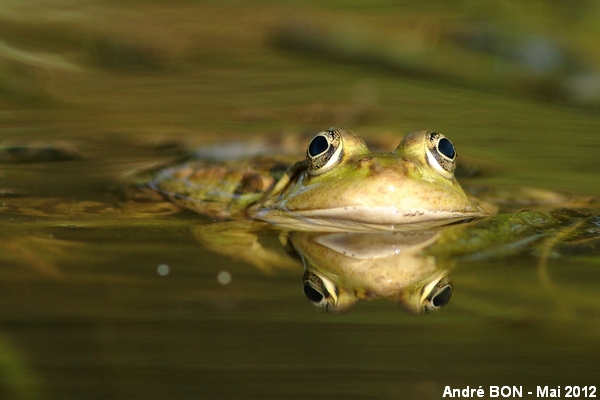
|
The identification of this species is based on the size of the frog and on the colour of the resonators. I have been able to see them multiple times and they appeared to me to be white. The iris is neither very dark nor uniform golden yellow. I have shot this picture while I was testing my floating hut for the very first time. As birds flew away from my hide, which was rather disappointing, I turned my camera towards the numerous Edible Frogs which were surrounding me. |
| [To know more about the Green Frogs] [Next picture] [Previous picture] [Top] |
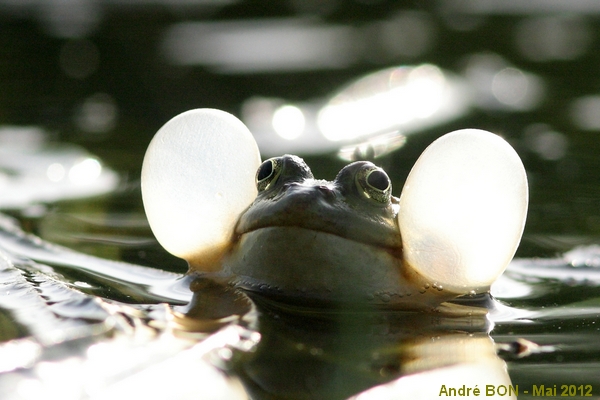
|
The resonators appeared very white to me, this eliminates the Marsh Frog species which is the only other possible large size species. However I plan to go back there to record the frogs' song. |
| [To know more about the Green Frogs] [Next picture] [Previous picture] [Top] |
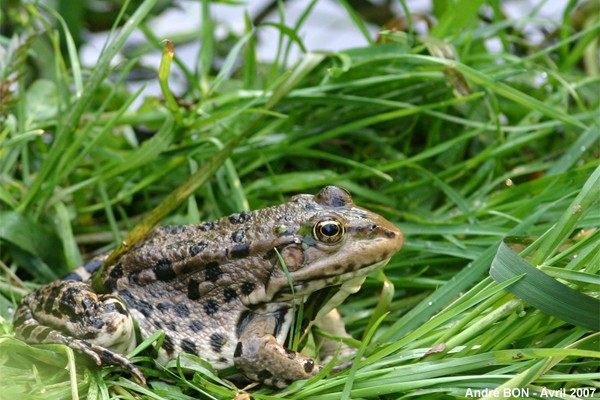
|
I am used to observing many frogs in this small pool next to a forest track. I am hesitating between the Edible Frog and the Marsh Frog. Here is another place where I will come back to record the frogs' song. |
| [To know more about the Green Frogs] [Next picture] [Previous picture] [Top] |
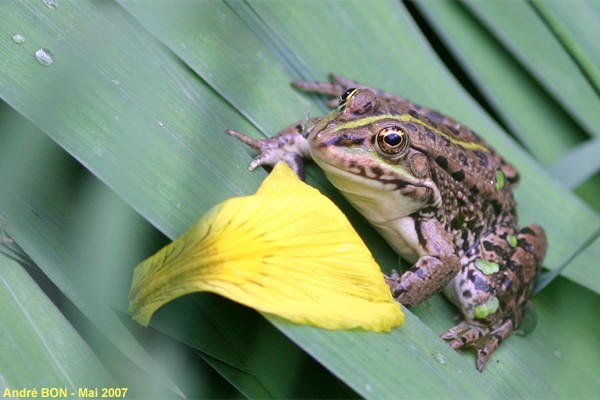
|
This beautiful frog was holding one yellow flower in its mouth when I came to the pond. Just the time to extract the camera from my backpack, it had released it. |
| [To know more about the Green Frogs] [Next picture] [Previous picture] [Top] |
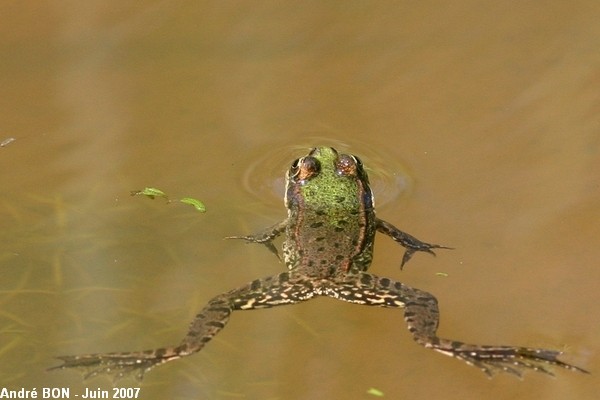
|
This photo shows the back of the thighs and the webbed hind legs but it is not sufficient to identify the species. |
| [To know more about the Green Frogs] [Next picture] [Previous picture] [Top] |
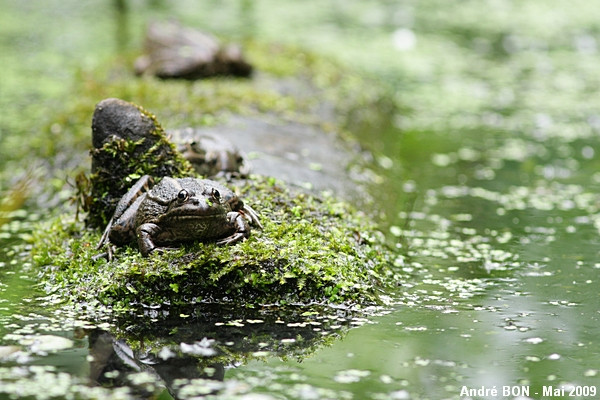
|
I have walked down next to water to shoot the picture at the height of the frog's eyes. |
| [To know more about the Green Frogs] [Next picture] [Previous picture] [Top] |
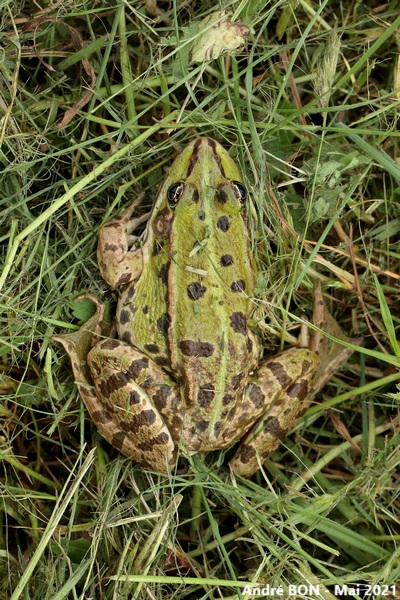
|
The yard of the old farm from my childhood, unused for several years, has become covered with tall grass. It was while mowing these grasses that I disturbed this Green Frog. |
| [To know more about the Green Frogs] [Next picture] [Previous picture] [Top] |

|
A front photo before resuming mowing the lawn, taking care to spare the area where the frog has taken refuge. |
| [To know more about the Green Frogs] [Previous picture] [Top] |
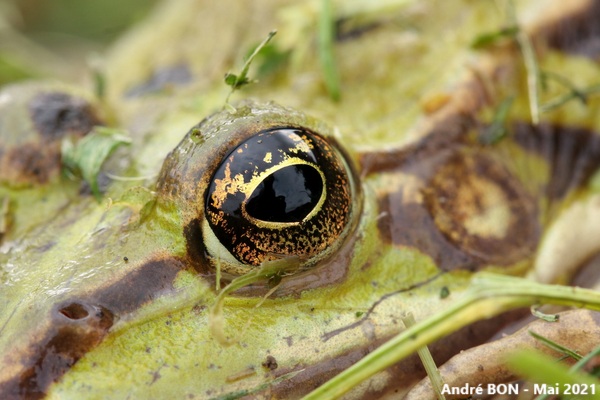
|
Close-up of the eye. I don't know if the colour of the iris can help for identification. |